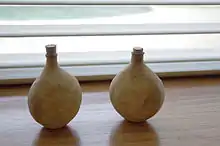| Kannauj Perfume | |
|---|---|
| Geographical indication | |
 Camel skin perfume bottles from Kannauj. The bottles are for aging the perfume. | |
| Alternative names | Ittar |
| Description | Kannauj Perfume in Uttar Pradesh |
| Type | Manufactured |
| Area | Kannauj, Uttar Pradesh |
| Country | India |
| Registered | 2013–2014 |
| Material | Flowers, herbs, spices |
Kannauj Perfume, also known as Kannauj Ittar, is a traditional Indian perfume made in the city of Kannauj in Uttar Pradesh.[1]
It has been protected under the Geographical indication (GI) of the Agreement on Trade-Related Aspects of Intellectual Property Rights (TRIPS) agreement. Kannauj Perfume is listed as item 157 of the GI Act 1999, which was passed by the Government of India.[2]
Kannauj's perfume sector has a storied history. Due to the role of perfume production in Kannauj, the city is known as "the perfume capital of India". Additionally, one writer said that "Kannauj is to India what Grasse is to France".[3][4] An expert stated that "Kannauj has been the perfumery town of the country for thousands of years".[5]
The skills used to manufacture the perfume have been passed down through successive generations. In describing this process, one artisan said, "My family has been working in this field since three centuries and my son is the 30th generation".
The perfume is made from flowers and natural resources. Musk, camphor, saffron and other aromatic substances are also used in its production. Flowers like white jasmine and plants such as vetiver are used for summer varieties, while soil is used for a monsoon variety, called Mitti attar. The smell of Mitti attar resembles petrichor, the loamy smell of a first rain.[6] Heena attar and musk attar are winter varieties.[7]
The perfume does not usually contain alcohol or other chemicals. Perfume made from rose is more potent, while attar made from sandalwood oil lasts for a long time. The typical creation process of a small bottle takes roughly 15 days.[8]
Kannauj perfume has reached both local and international markets. Around 20 companies export to foreign countries from North America and Europe, to the Middle East, Central Asia and Oceania.[9]
See also
References
- ↑ "UP के एक शहर की विदेशों तक फैल रही खुशबू, क्या आप जानते हैं इसकी खासियत? | Kannauj perfume history about interesting facts". Patrika News (in Hindi). 23 February 2023. Retrieved 14 March 2023.
- ↑ "State Wise Registration Details Of G.I Applications" (PDF). Controller General of Patents Designs and Trademarks. Archived from the original (PDF) on 1 February 2016. Retrieved 4 February 2016.
- ↑ "Geographical Indications tag for Nagpur orange, Kannauj perfume". The Times of India. 26 April 2014. Retrieved 4 February 2016.
- ↑ Brand Building and Marketing in Key Emerging Markets: A Practitioner's Guide to Successful Brand Growth in China, India, Russia and Brazil. Springer. 2015. p. 405. ISBN 978-3-319-19482-0.
- ↑ "Life: India's perfume capital threatened by scent of modernity". The Taipei Times. 20 September 2012. Retrieved 10 February 2016.
- ↑ "Mitti attar: Take home that lush smell of the first rain, trapped in a bottle". Hindustan Times. 2 July 2016. Retrieved 6 February 2023.
- ↑ "The great Indian Tadka". The Daily Pioneer. Retrieved 10 February 2016.
- ↑ "Fading fragrance of Kannauj, India's perfume capital". Travel CNN. Retrieved 10 February 2016.
- ↑ "Attar losing fragrance in Kannauj, perfurmers unhappy with Yadav clan". The Times of India. 22 April 2014. Retrieved 10 February 2016.
- Bibliography
- Report on the marketing of sandalwood oil in India. Directorate of Marketing & Inspection, Ministry of Rural Development, Govt. of India. 1986. p. 141.
- Vashist, V. N. (1978). The Essential Oil and Perfumery Industry in North India. Essential Oil Association of India. p. 63.